Table of Contents
From the moment you wake up, whether you realize it or not, you start making decisions. Turn the alarm off. Turn the lights on. Look outside to see what the weather is like. Brush your teeth. Put on your robe and wizard hat. Check your calendar. Basically...you get the point. By the time you step outside your door, you consciously or subconsciously will have made hundreds of decisions with each decision having a certain effect on what you ended up doing.
For example, if the weather looks cold outside, you might decide to wear a hoodie or a jacket. You can model this decision as follows:
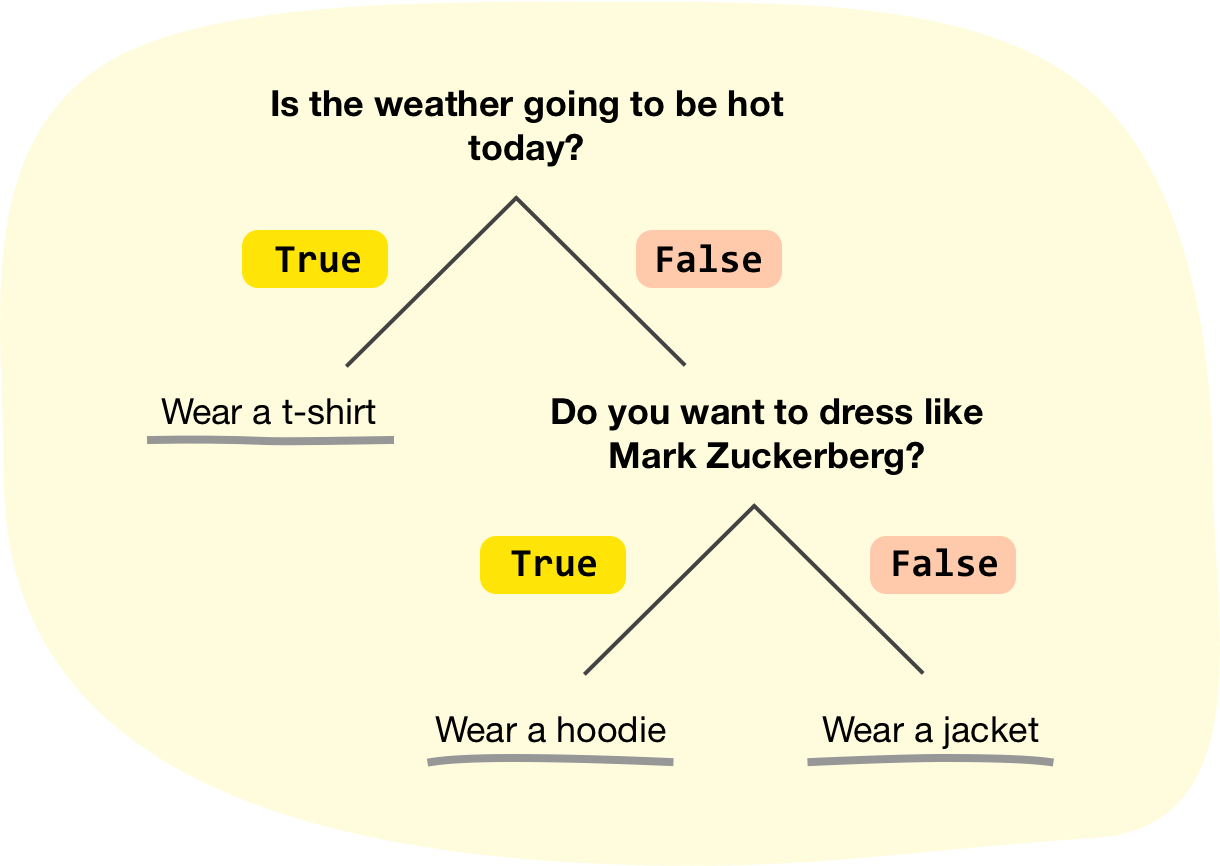
At each stage of making a decision, you ask yourself a question that can be answered as true or false. The answer to that question determines your next step and ultimately whether you were a t-shirt, hoodie, or jacket. Going more broad, every decision you and I make can be modeled as a series of true and false statements. This may sound a bit chilly (☃️), but that's generally how we, others, and pretty much all living things go about making choices.
This generalization especially applies to everything our computer does. This may not be evident from the code we've written so far, but we are going to fix that. In this tutorial, we will cover what is known as conditional statements. These are the digital equivalents of the decisions we make where our code does something different depending on whether something is true or false.
Onwards!
The most common conditional statement we will use in our code is the if / else statement or just the if statement. The way this statement works is as follows:
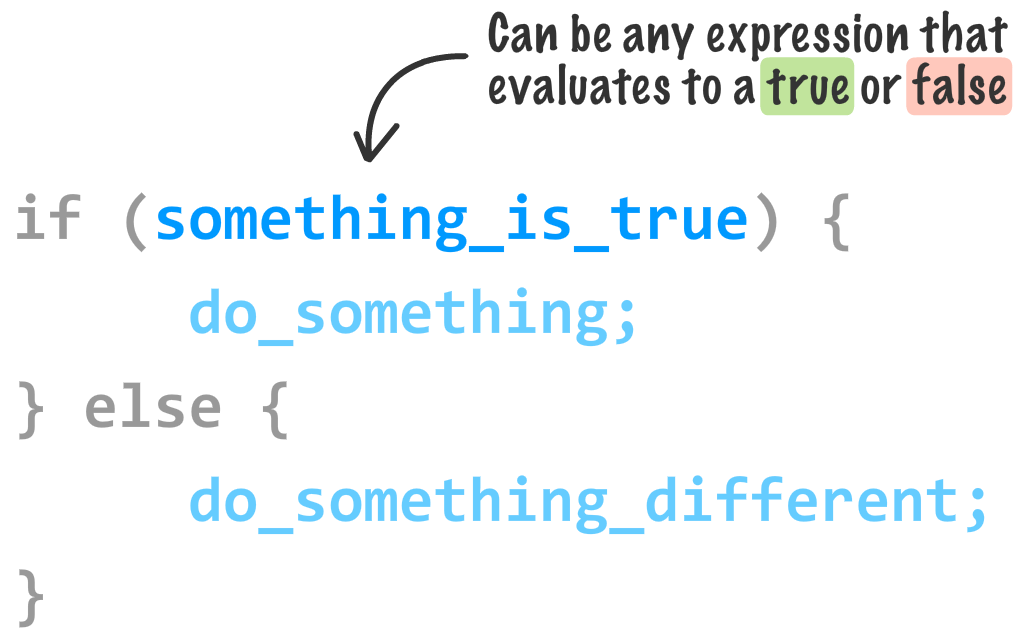
To make sense of this, let's take a look at a simple example of an if / else statement in action. Create a new HTML document and add the following markup and code into it:
<!DOCTYPE html>
<html>
<head>
<meta charset="utf-8">
<title>If / Else Statements</title>
<style>
</style>
</head>
<body>
<script>
let safeToProceed = true;
if (safeToProceed) {
alert("You shall pass!");
} else {
alert("You shall not pass!");
}
</script>
</body>
</html>Save this document with the name if_else.htm and preview it in your browser. If all worked as expected, you will see an alert with the text You shall pass! displayed:
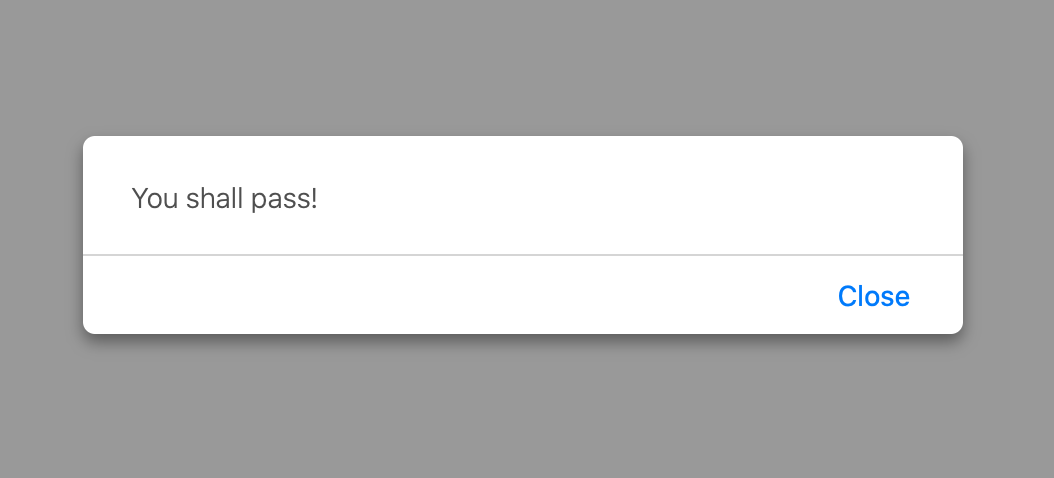
The code responsible for making this work is the following lines from our example:
let safeToProceed = true;
if (safeToProceed) {
alert("You shall pass!");
} else {
alert("You shall not pass!");
}Our expression (the thing following the keyword if that ultimately evaluates to true or false) is the variable safeToProceed. This variable is initialized to true, so the true part of our if statement kicked in.
Now, go ahead and change the value of the safeToProceed variable from a true to a false:
let safeToProceed = false;
if (safeToProceed) {
alert("You shall pass!");
} else {
alert("You shall not pass!");
}This time when you run this code, you will see an alert with the text You shall not pass! because our expression now evaluates to false:
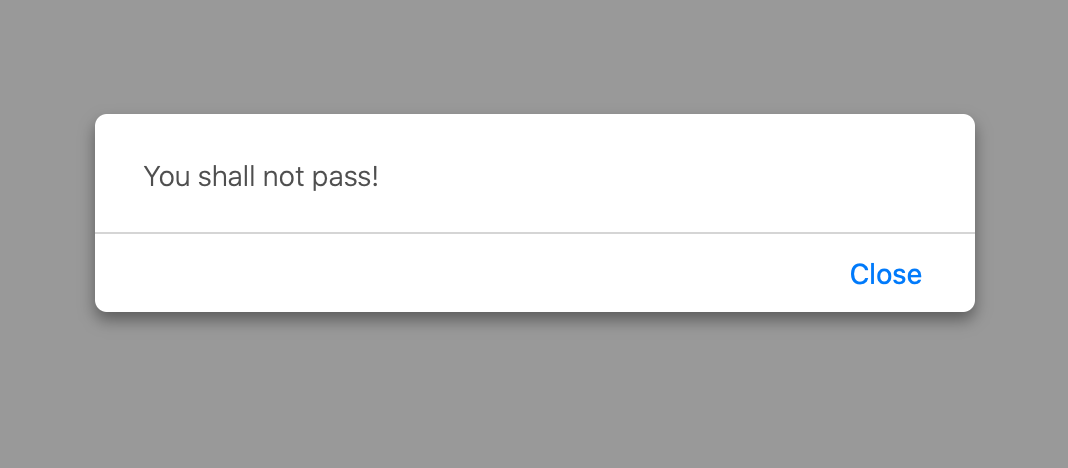
So far, all of this should seem really boring. A large part of the reason for this is because we haven't turned up the complexity knob to focus on more realistic scenarios. We'll tackle that next by taking a deeper look at conditions.
In most cases, our expression will rarely be a simple variable that is set to true or false like it is in our earlier example. Our expression will involve what are known as conditional operators that help us to compare between two or more expressions to establish a true or false outcome.
The general format of such expressions are:
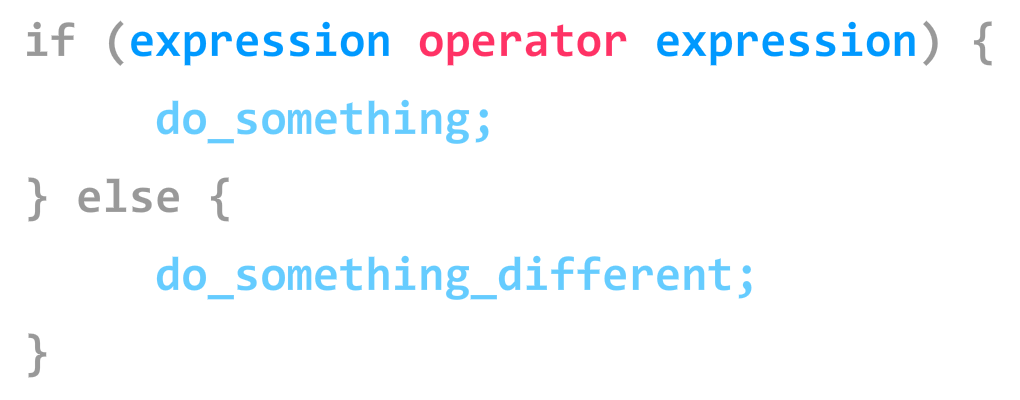
The operator (aka a conditional operator) defines a relationship between an expression The end goal is to return a true or a false so that our if statement knows which block of code to execute. Key to making all of this work are the conditional operators themselves. They are:
| Operator | When it is true |
|---|---|
| == | If the first expression evaluates to something that is equal to the second expression. |
| >= | If the first expression evaluates to something that is greater or equal to the second expression |
| > | If the first expression evaluates to something that is greater than the second expression |
| <= | If the first expression evaluates to something that is lesser or equal to the second expression |
| < | If the first expression evaluates to something that is less than the second expression |
| != | If the first expression evaluates to something that is not equal to the second expression |
| && | If the first expression and the second expression both evaluate to true |
| || | If either the first expression or the second expression evaluate to true |
Let's take our general understanding of conditional operators and make it more specific by looking at another example...such as the following with our relevant if-related code highlighted:
<!DOCTYPE html>
<html>
<head>
<meta charset="utf-8">
<title>Are you speeding?</title>
<style>
</style>
</head>
<body>
<script>
var speedLimit = 55;
function amISpeeding(speed) {
if (speed >= speedLimit) {
alert("Yes. You are speeding.");
} else {
alert("No. You are not speeding. What's wrong with you?");
}
}
amISpeeding(53);
amISpeeding(72);
</script>
</body>
</html>Let's take a moment to understand what exactly is going on. We have a variable called speedLimit that is initialized to 55. We then have a function called amISpeeding that takes an argument named speed. Inside this function, we have an if statement whose expression checks if the passed in speed value is greater than or equal (Hello >= conditional operator!) to the value stored by the speedLimit variable:
function amISpeeding(speed) {
if (speed >= speedLimit) {
alert("Yes. You are speeding.");
} else {
alert("No. You are not speeding. What's wrong with you?");
}
}The last thing our code does is actually call the amISpeeding function by passing in a few values for speed:
amISpeeding(53);
amISpeeding(72);When we call this function with a speed of 53, the speed >= speedLimit expression evaluates to false. The reason is that 53 is not greater than or equal to the stored value of speedLimit which is 55. This will result in an alert showing that you aren't speeding.
The opposite happens when we call amISpeeding with a speed of 72. In this case, we are speeding and the condition evaluates to a true. An alert telling us that we are speeding will also appear.
The thing you need to know about these expressions is that they can be as simple or as complex as you can make them. They can be made up of variables, function calls, or raw values. They can even be made up of combinations of variables, function calls, or raw values all separated using any of the operators you saw earlier. The only thing that you need to ensure is that your expresion ultimately evaluates to a true or a false.
Here is a slightly more involved example:
let xPos = 300;
let yPos = 150;
function sendWarning(x, y) {
if ((x < xPos) && (y < yPos)) {
alert("Adjust the position");
} else {
alert("Things are fine!");
}
}
sendWarning(500, 160);
sendWarning(100, 100);
sendWarning(201, 149);Notice what our condition inside sendWarning's if statement looks like:
function sendWarning(x, y) {
if ((x < xPos) && (y < yPos)) {
alert("Adjust the position");
} else {
alert("Things are fine!");
}
}There are three comparisons being made here. The first one is whether x is less than xPos. The second one is whether y is less than yPos. The third comparison is seeing if the first statement and the second statement both evaluate to true to allow the && operator to return a true as well. We can chain together many series of conditional statements together depending on what we are doing. The tricky thing, besides learning what all the operators do, is to ensure that each condition and sub-condition is properly insulated using parentheses.
All of what we are describing here and in the previous section falls under the umbrella of Boolean Logic. If you are not familiar with this topic, I recommend you glance through the excellent quirksmode article on this exact topic.
We are almost done with the if statement. The last thing we are going to is look at are some of its relatives.
The first one is the solo if statement that doesn't have its else companion:
if (weight > 5000) {
alert("No free shipping for you!");
}In this case, if the expression evaluates to true, then great. If the expression evaluates to false, then your code just skips over the alert and just moves on to wherever it needs to go next. The else block is completely optional when working with if statements. To contrast the if-only statement, we have our next relative...
Not everything can be neatly bucketed into a single if or if / else statement. For those kinds of situations, you can chain if statements together by using the else if keyword. Instead of explaining this further, let's just look at an example:
if (position < 100) {
alert("Do something!");
} else if ((position >= 200) && (position < 300)) {
alert("Do something else!");
} else {
alert("Do something even more different!");
}If the first if statement evaluates to true, then our code branches into the first alert. If the first if statement is false, then our code evaluates the else if statement to see if the expressions in it evaluate to a true or false. This repeats until our code reaches the end. In other words, our code simply navigates down through each if and else if statement until one of the expressions evaluates to true:
if (condition) {
...
} else if (condition) {
...
} else if (condition) {
...
} else if (condition) {
...
} else if (condition) {
...
} else if (condition) {
...
} else {
...
}If none of the statements have expressions that evaluate to true, the code inside the else block (if it exists) executes. If there is no else block, then the code will just go on to the next set of code that lives beyond all these if statements. Between the more complex expressions and if / else if statements, you can represent pretty much any decision that your code might need to evaluate.
And with this, you have learned all there is to know about the if statement. It's time to move on to a wholse different species of conditional statement...
In a world filled with beautiful if, else, and else if statements, the need for yet another way of dealing with conditionals may seem unnecessary. People who wrote code on room-sized machines and probably hiked uphill in snow (with wolves chasing them) disagreed, so we have what are known as switch statements. What are they? We are going to find out!
We are going to cut to the chase and look at the code first. The basic structure of a switch statement is as follows:
switch (expression) {
case value1:
statement;
break;
case value2:
statement;
break;
case value3:
statement;
break;
default:
statement;
break;
}The thing to never forget is that a switch statement is nothing more than a conditional statement that tests whether something is true or false. That something is a variation of whether the result of evaluating the expression equals a case value. Let's make this explanation actually make sense by looking at a better example:
let color = "green";
switch (color) {
case "yellow":
alert("yellow color");
break;
case "red":
alert("red color");
break;
case "blue":
alert("blue color");
break;
case "green":
alert("green color");
break;
case "black":
alert("black color");
break;
default:
alert("no known color specified");
break;
}In this simple example, we have a variable called color whose value is set to green:
let color = "green";The color variable is also what we specify as our expression to the switch statement:
switch (color) {
case "yellow":
alert("yellow color");
break;
case "red":
alert("red color");
break;
case "blue":
alert("blue color");
break;
case "green":
alert("green color");
break;
case "black":
alert("black color");
break;
default:
alert("no known color specified");
break;
}Our switch statement contains a collection of case blocks. Only one of these blocks will get hit with their code getting executed. The way this chosen one gets picked is by matching a block's case value with the result of evaluating the expression. In our case, because our expression's evaluates to a value of green, the code inside the case block whose case value is also green gets executed:
switch (color) {
case "yellow":
alert("yellow color");
break;
case "red":
alert("red color");
break;
case "blue":
alert("blue color");
break;
case "green":
alert("green color");
break;
case "black":
alert("black color");
break;
default:
alert("no known color specified");
break;
}Note that only the code inside the green case block gets executed. That is thanks to the break keyword that ends that block. When your code hits the break, it exits the entire switch block and continues executing the code that lies below it. If you did not specify the break keyword, you will still execute the code inside the green case block. The difference is that you will then move to the next case block (the black one in our example) and execute any code that is there. Unless you hit another break keyword, your code will just move through every single case block until it reaches the end.
With all of this said, if you were to run this code, you will see an alert window that looks as follows:
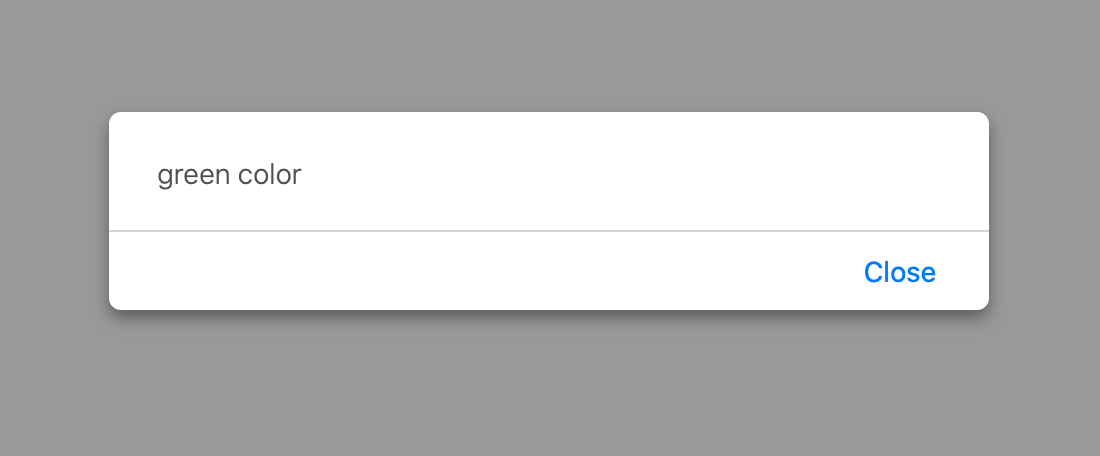
You can alter the value for the color variable to other valid values to see the other case blocks execute. Sometimes, no case block's value will match the result of evaluating an expression. In those cases, your switch statement will just do nothing. If you wish to specify a default behavior, add a default block:
switch (color) {
case "yellow":
alert("yellow color");
break;
case "red":
alert("red color");
break;
case "blue":
alert("blue color");
break;
case "green":
alert("green color");
break;
case "black":
alert("black color");
break;
default:
alert("no known color specified");
break;
}Note that the default block looks a bit different than your other case statements. It actually doesn't contain the word case.
At the beginning, we saw that a switch statement is used for evaluating conditions - just like the if / else statement that we spent a bulk of our time on here. Given that this is a major accusation, let's explore this in further detail by first looking at how an if statement would look if it were to be literally translated into a switch statement.
Let's say we have an if statement that looks as follows:
let number = 20;
if (number > 10) {
alert("yes");
} else {
alert("nope");
}Because the value of our number variable is 20, our if statement will evaluate to a true. Seems pretty straightforward. Now, let's turn this into a switch statement:
switch (number > 10) {
case true:
alert("yes");
break;
case false:
alert("nope");
break;
}Notice that our expression is number > 10. The case value for the case blocks is set to true or false. Because number > 10 evaluates to true, the code inside the true case block gets executed. While your expression in this case wasn't as simple as reading a color value stored in a variable like in the previous section, our view of how switch statements work still hasn't changed. Our expressions can be as complex as you would like. If they evaluate to something that can be matched inside a case value, then everything is golden...like a fleece!
Now, let's look at a slightly more involved example. This time, we will convert our earlier switch statement involving colors into equivalent if / else statements. The switch statement we used earlier looks as follows:
let color = "green";
switch(color) {
case "yellow":
alert("yellow color");
break;
case "red":
alert("red color");
break;
case "blue":
alert("blue color");
break;
case "green":
alert("green color");
break;
case "black":
alert("black color");
break;
default:
alert("no color specified");
break;
}This switch statement converted into a series of if / else statements would look like this:
let color = "green";
if (color == "yellow") {
alert("yellow color");
} else if (color == "red") {
alert("red color");
} else if (color == "blue") {
alert("blue color");
} else if (color == "green") {
alert("green color");
} else if (color == "black") {
alert("black color");
} else {
alert("no color specified";
}As we can see, if / else statements are very similar to switch statements and vice versa. The default case block becomes an else block. The relationship between the expression and the case value in a switch statement is combined into if / else conditions in an if / else statement.
In the previous section, we saw how interchangeable switch statements and if / else statements are. When we have two ways of doing something very similar, it is only natural to want to know when it is appropriate to use one over the other. In a nutshell, use whichever one you prefer. There are many arguments on the web about when to use switch vs an if / else, and the one thing is that they are all inconclusive.
My personal preference is to go with whatever is more readable. If you look at the comparisons earlier between switch and if / else statements, you'll notice that if you have a lot of conditions, your switch statement tends to look a bit cleaner. It is certainly less verbose and a bit more readable. What your cutoff mark is for deciding when to switch (ha!) between using a switch statement and an if / else statement is entirely up to you. I tend to draw the line at around four or five conditions.
Second, a switch statement works best when you are evaluating an expression and matching the result to a value. If you are doing something more complex involving weird conditions, value checking, etc., you probably want to use something different. That could involve something even more different than a if / else statement, by the way! We will touch upon those different somethings later on.
To wrap this all up, the earlier guidance still stands: use whatever you like. If you are part of a team with coding guidelines, then follow them instead. Whatever you do, just be consistent. It makes your life as well as the life of anybody else who will be working in your code a little bit easier. For what it is worth, I've personally never been in a situation where I had to use a switch statement. Your mileage may vary.
Just a final word before we wrap up. If you have a question and/or want to be part of a friendly, collaborative community of over 220k other developers like yourself, post on the forums for a quick response!

:: Copyright KIRUPA 2024 //--